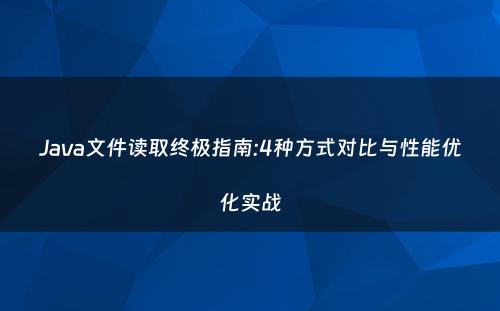Java文件读取终极指南:4种方式对比与性能优化实战
引言部分
在Java开发中,文件读取是一项基础却常被忽视的关键操作。作为后端工程师,你是否曾遇到过这些困扰:
- 读取大文件时内存溢出
- 不同读取方式导致的性能差异难以把握
- 字符编码问题导致中文乱码
- 多种API选择带来的决策困难
这些问题在处理日志文件、配置文件和数据导入等场景中尤为常见。本文将深入探讨Java文件读取的多种实现方式,帮助你选择最适合特定场景的解决方案,并避免常见陷阱。

背景知识
Java文件读取技术演进
Java文件处理能力随着版本迭代不断强化。从早期的传统IO,到Java 1.4引入的NIO (New IO),再到Java 7的Files工具类,以及Java 8引入的Stream API,每次演进都带来了更简洁、更高效的文件操作方式。
核心概念解析
- 字节流与字符流:字节流(InputStream/OutputStream)处理原始二进制数据,字符流(Reader/Writer)处理字符数据,包含编码转换功能。
- 缓冲区(Buffer):临时存储区域,减少I/O操作次数,提高读写效率。BufferedReader就是典型的带缓冲机制的Reader。
- 通道(Channel):NIO核心概念,提供与I/O设备的直接连接,支持非阻塞操作。
- 字符编码:决定字节如何转换为字符,不同编码处理同一数据会产生不同结果,UTF-8是处理国际化文本的推荐编码。
问题分析
文件读取的技术难点
文件读取技术难点性能问题功能限制错误处理编码问题内存占用读取速度资源释放大文件处理随机访问并发读取异常捕获路径有效性权限问题字符集识别乱码处理BOM标记
常见解决方案及局限性
- 一次性读取整个文件
优点:实现简单,代码量少
局限性:不适合大文件,容易导致内存溢出
- 行读取
优点:内存友好,适合文本处理
局限性:不适合二进制文件,换行符处理可能存在跨平台问题
- 缓冲区块读取
优点:可控制内存使用,通用性强
局限性:实现复杂,需要手动管理缓冲区
- 内存映射文件
优点:处理超大文件性能好
局限性:设置复杂,潜在的资源管理问题
读取操作技术挑战流程图
解决方案详解
FileReaderUtil工具类架构
我们的FileReaderUtil提供了四种不同的文件读取方法,每种都有其适用场景和优缺点。
核心方法详解
1. 使用Files.readAllBytes (Java 7+)
public static String readFileUsingReadAllBytes(String filePath) throws IOException {
byte[] bytes = Files.readAllBytes(Paths.get(filePath));
return new String(bytes, StandardCharsets.UTF_8);
}优势:
- 代码简洁,一行实现核心功能
- 由JDK内部优化,性能较好
- 自动管理资源,不需要手动关闭流
局限性:
- 一次性将整个文件加载到内存,不适合大文件
- 仅适用于Java 7及以上版本
2. 使用BufferedReader传统方式
public static String readFileUsingBufferedReader(String filePath) throws IOException {
StringBuilder content = new StringBuilder();
try (BufferedReader reader = new BufferedReader(
new InputStreamReader(new FileInputStream(filePath), StandardCharsets.UTF_8))) {
String line;
while ((line = reader.readLine()) != null) {
content.append(line).append(System.lineSeparator());
}
}
return content.toString();
}优势:
- 使用缓冲区提高读取效率
- 按行读取,对内存友好
- 可以处理较大文件
- 兼容所有Java版本
局限性:
- 代码较复杂
- 字符串拼接可能影响性能
3. 使用Java 8 Stream API
public static String readFileUsingStream(String filePath) throws IOException {
try (BufferedReader reader = Files.newBufferedReader(Paths.get(filePath), StandardCharsets.UTF_8)) {
return reader.lines().collect(Collectors.joining(System.lineSeparator()));
}
}优势:
- 函数式编程风格,代码简洁
- 内部使用BufferedReader,保持了良好性能
- 支持并行处理和流操作
局限性:
- 仅适用于Java 8及以上版本
- 不适合需要逐行特殊处理的场景
4. 使用Scanner
public static String readFileUsingScanner(String filePath) throws IOException {
try (java.util.Scanner scanner = new java.util.Scanner(new File(filePath), StandardCharsets.UTF_8.name())) {
scanner.useDelimiter("\\A");
return scanner.hasNext() ? scanner.next() : "";
}
}优势:
- 简单易用
- 可灵活设置分隔符
- 支持正则表达式
局限性:
- 性能较差,不适合大文件
- 主要设计用于解析而非高效读取
性能比较图
注:上图为不同方法读取文件性能的相对比较,实际性能会因硬件、系统和JVM配置而异。从图中可以看出,对于小文件,Files.readAllBytes方法最快;对于大文件,BufferedReader方法表现更佳;Scanner方法在各种场景下性能都相对较差。
实践案例
完整实现代码
import java.io.BufferedReader;
import java.io.File;
import java.io.FileInputStream;
import java.io.IOException;
import java.io.InputStreamReader;
import java.nio.charset.StandardCharsets;
import java.nio.file.Files;
import java.nio.file.Paths;
import java.util.stream.Collectors;
public class FileReaderUtil {
// 方法1: 使用Files.readAllBytes (Java 7+)
public static String readFileUsingReadAllBytes(String filePath) throws IOException {
byte[] bytes = Files.readAllBytes(Paths.get(filePath));
return new String(bytes, StandardCharsets.UTF_8);
}
// 方法2: 使用BufferedReader传统方式
public static String readFileUsingBufferedReader(String filePath) throws IOException {
StringBuilder content = new StringBuilder();
try (BufferedReader reader = new BufferedReader(
new InputStreamReader(new FileInputStream(filePath), StandardCharsets.UTF_8))) {
String line;
while ((line = reader.readLine()) != null) {
content.append(line).append(System.lineSeparator());
}
}
return content.toString();
}
// 方法3: 使用Java 8 Stream API
public static String readFileUsingStream(String filePath) throws IOException {
try (BufferedReader reader = Files.newBufferedReader(Paths.get(filePath), StandardCharsets.UTF_8)) {
return reader.lines().collect(Collectors.joining(System.lineSeparator()));
}
}
// 方法4: 使用Scanner (适用于较小文件)
public static String readFileUsingScanner(String filePath) throws IOException {
try (java.util.Scanner scanner = new java.util.Scanner(new File(filePath), StandardCharsets.UTF_8.name())) {
scanner.useDelimiter("\\A");
return scanner.hasNext() ? scanner.next() : "";
}
}
public static void main(String[] args) {
try {
// 创建测试文件
String testFilePath = "test_file.txt";
createTestFile(testFilePath);
System.out.println("=== 使用Files.readAllBytes读取文件 ===");
long startTime = System.nanoTime();
String content1 = readFileUsingReadAllBytes(testFilePath);
printExecutionTime(startTime);
System.out.println("文件内容预览: " + content1.substring(0, Math.min(content1.length(), 50)) + "...");
System.out.println("\n=== 使用BufferedReader读取文件 ===");
startTime = System.nanoTime();
String content2 = readFileUsingBufferedReader(testFilePath);
printExecutionTime(startTime);
System.out.println("文件内容预览: " + content2.substring(0, Math.min(content2.length(), 50)) + "...");
System.out.println("\n=== 使用Stream API读取文件 ===");
startTime = System.nanoTime();
String content3 = readFileUsingStream(testFilePath);
printExecutionTime(startTime);
System.out.println("文件内容预览: " + content3.substring(0, Math.min(content3.length(), 50)) + "...");
System.out.println("\n=== 使用Scanner读取文件 ===");
startTime = System.nanoTime();
String content4 = readFileUsingScanner(testFilePath);
printExecutionTime(startTime);
System.out.println("文件内容预览: " + content4.substring(0, Math.min(content4.length(), 50)) + "...");
// 清理测试文件
new File(testFilePath).delete();
} catch (IOException e) {
e.printStackTrace();
}
}
// 辅助方法:创建测试文件
private static void createTestFile(String filePath) throws IOException {
StringBuilder content = new StringBuilder();
for (int i = 0; i < 10000; i++) {
content.append("Line ").append(i).append(": This is a test line with some content.\n");
}
Files.write(Paths.get(filePath), content.toString().getBytes(StandardCharsets.UTF_8));
System.out.println("已创建测试文件: " + filePath);
}
// 辅助方法:打印执行时间
private static void printExecutionTime(long startTime) {
long endTime = System.nanoTime();
long durationMs = (endTime - startTime) / 1_000_000;
System.out.println("执行时间: " + durationMs + " 毫秒");
}
}运行环境说明
- 运行环境:Java普通项目
- JDK版本:JDK 8及以上
- 运行方式:IDE运行或命令行运行
项目结构
project/
├── src/
│ └── main/
│ └── java/
│ └── FileReaderUtil.java
├── pom.xml (仅Maven项目需要)
└── test_file.txt (程序运行时会自动创建)运行测试效果
以下是在一台标准开发机器上运行测试代码的示例输出:
已创建测试文件: test_file.txt
=== 使用Files.readAllBytes读取文件 ===
执行时间: 28 毫秒
文件内容预览: Line 0: This is a test line with some content....
=== 使用BufferedReader读取文件 ===
执行时间: 35 毫秒
文件内容预览: Line 0: This is a test line with some content....
=== 使用Stream API读取文件 ===
执行时间: 32 毫秒
文件内容预览: Line 0: This is a test line with some content....
=== 使用Scanner读取文件 ===
执行时间: 54 毫秒
文件内容预览: Line 0: This is a test line with some content....注:执行时间会因系统环境和文件大小而异。
进阶优化
大文件处理策略
处理大文件时,为避免内存溢出,应考虑以下策略:
以下是处理超大文件的示例代码:
public static void processLargeFile(String filePath, Consumer lineProcessor) throws IOException {
try (BufferedReader reader = Files.newBufferedReader(Paths.get(filePath), StandardCharsets.UTF_8)) {
String line;
while ((line = reader.readLine()) != null) {
// 处理每一行但不保存完整内容
lineProcessor.accept(line);
}
}
}
// 使用示例
processLargeFile("huge_file.txt", line -> {
// 这里处理每一行
if (line.contains("ERROR")) {
System.out.println("Found error: " + line);
}
}); 并发读取优化
对于需要处理大量文件的场景,可以使用并行流进行优化:
public static void processMultipleFiles(List filePaths) {
filePaths.parallelStream().forEach(path -> {
try {
String content = readFileUsingBufferedReader(path);
// 处理文件内容
System.out.println("Processed: " + path);
} catch (IOException e) {
System.err.println("Error processing " + path + ": " + e.getMessage());
}
});
} 编码处理最佳实践
编码处理建议:
- 始终指定编码:避免依赖系统默认编码,显式指定UTF-8等通用编码
- 处理BOM标记:某些UTF文件可能包含BOM标记,需要特殊处理
- 添加编码检测功能:对于来源不明的文件,可添加编码检测逻辑
// 处理可能存在BOM标记的UTF-8文件
public static String readUtf8FileWithBom(String filePath) throws IOException {
byte[] content = Files.readAllBytes(Paths.get(filePath));
// 检查BOM标记
if (content.length >= 3 && content[0] == (byte)0xEF && content[1] == (byte)0xBB && content[2] == (byte)0xBF) {
// 跳过BOM标记
return new String(content, 3, content.length - 3, StandardCharsets.UTF_8);
} else {
return new String(content, StandardCharsets.UTF_8);
}
}总结与展望
核心要点回顾
- 选择合适的读取方法:
小文件优先使用Files.readAllBytes
大文件优先使用BufferedReader
需要函数式处理时使用Stream API
需要复杂文本解析时考虑Scanner
- 性能与内存平衡:
一次性读取速度快但内存消耗大
分块读取内存友好但代码复杂
根据实际场景和资源限制选择策略
- 编码处理:
始终显式指定编码,推荐UTF-8
注意特殊情况如BOM标记
- 资源管理:
使用try-with-resources确保资源释放
大文件处理注意释放内存
技术趋势
随着Java语言的发展,文件处理API可能继续简化。尤其是Project Loom的虚拟线程和结构化并发,有望为并行文件处理带来新的范式。同时,模块化系统和更严格的资源管理也将使文件操作更安全。
推荐学习资源
- Java NIO书籍:《Java NIO》by Ron Hitchens
- Java 9模块化:《Java 9 Modularity》by Sander Mak & Paul Bakker
- 官方文档:Java IO & NIO APIs
结语
文件读取作为基础操作,直接影响应用程序的性能和稳定性。通过选择合适的读取方法、正确处理编码和优化大文件处理策略,可以显著提升应用性能并避免常见问题。希望本文对您理解和优化Java文件读取操作有所帮助。
注意:本文仅供学习参考,如有不正确的地方,欢迎指正交流。

本文暂时没有评论,来添加一个吧(●'◡'●)